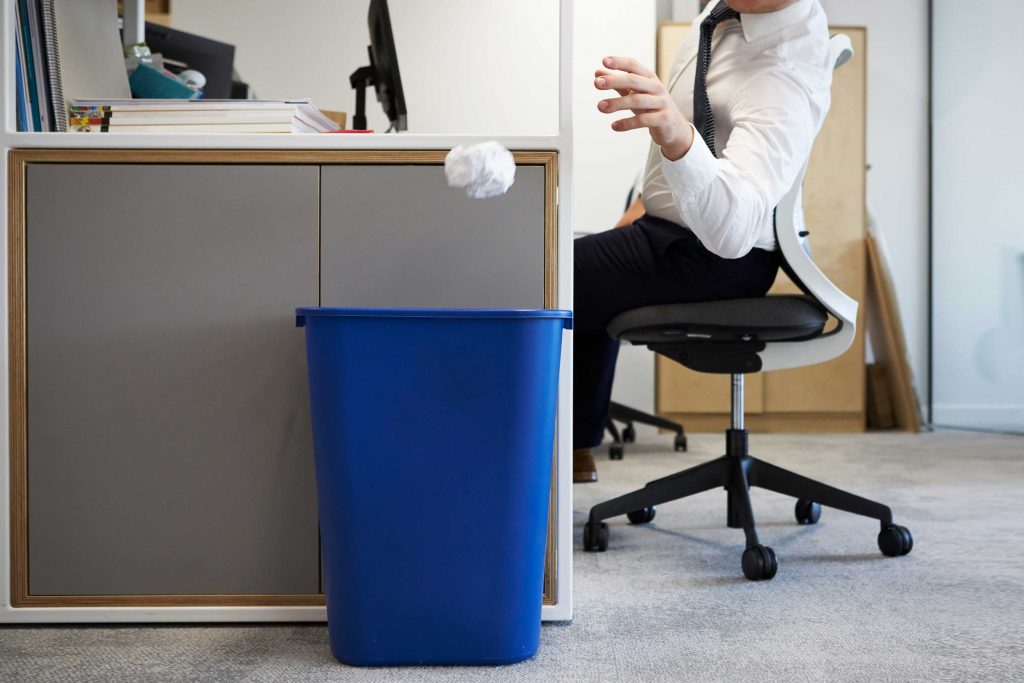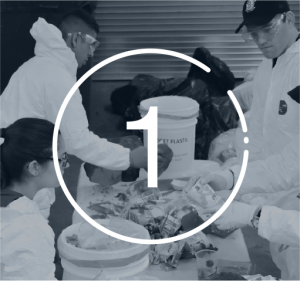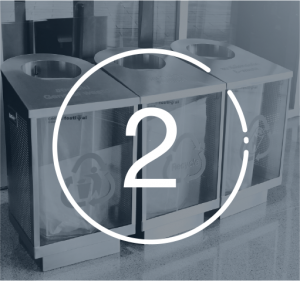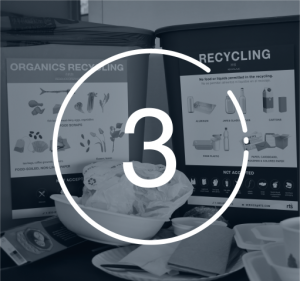Thinking about cutting ties with desk side bins in your office? RTS Sustainability Operations Manager, Shannon Bergstrom, sat down with Emily Kildow, Associate Director of Sustainability at Sidewalk Labs, to discuss her experience with implementing a centralized waste station while in her former role.
Centralized waste stations
While not new, centralized waste stations are beginning to see a resurgence in the workplace to encourage better waste practices. It’s a group of bins designated for multiple waste streams in a centralized location that require people to walk to in order to dispose of their waste in the appropriate bins.
Why should we have centralized waste stations instead of deskside bins?
“Centralized waste stations present an opportunity for employees feel as though they are participating in something that is related to sustainability. It’s an opportunity for employees to see a physical change or an initiative that they are contributing to in trying to keep materials in the correct waste stream”
– Emily Kildow
Deskside bins are notoriously a trash bin only, leading to contaminated waste streams and very little recycling. A centralized waste station eliminates the convenience of throwing something away without much thought and provides a solution to making sure waste materials are properly disposed of.
Emily also described the act of getting up from one’s desk to dispose of waste as a “Water Cooler Moment” that doesn’t really exist anymore, providing a chance for employees to interact with peers.
What did the planning and implementation period look like for you?
It’s important to note that Emily led this rollout for an existing building, but she stressed the importance for new or redesigned buildings to make it part of the design from the beginning. The result is setting up appropriate waste habits from the start.
Baseline Waste Audit
- Emily and her team led a waste audit to obtain baseline data. The goal was to determine how much recycling was occurring with existing deskside bins.
- Additionally, this helped them determine how many centralized bins they would need.
Bin Selection
- Through the process of choosing the right bin for the space, Emily interviewed tenants about their experience with existing bins. She and her team also considered accessibility for people in wheelchairs, janitorial staff interactions with the bins and their ease of taking out the waste, and finally, the color of the bins.
“Choose one color and stick with it throughout the space in order to keep the recycling program as consistent as possible throughout the building.”
Signage
- Ensuring appropriate signage and graphics for the bins were used was key to a successful program rollout.
- Emily also mentioned that based on her research, signage showing images of the actual waste items your employees are generating is most effective in combination with written words.
“Talk to vendors and haulers to make sure you know what materials are accepted in each waste stream in regards to what images you should include in signage.”
How was the program rolled out to employees?
Communication is key. To introduce the program to tenants, an email was sent two weeks prior to the rollout of the centralized waste stations. It included:
- Why centralized waste stations were going to be implemented
- When deskside bins would be taken away
- The role each individual tenant played in making this recycling program a success
“If you can introduce the centralized waste station program to managerial teams and get them on board with the program first, it will be much easier to get the individual tenants on board as they are more inclined to support a program their manager supports.”
Prior to the rollout, Emily also led several presentations for employees companywide to introduce the program and go into detail around why it was such an important initiative for the company to increase diversion rates. Employees had the opportunity to ask questions and feel they were a part of the initiative.
When the centralized waste stations were rolled out, Emily hosted an online forum for employees to provide real-time feedback and ask questions to her and her team.
What stakeholders did you engage to make this rollout a reality?
Key stakeholders involved from start to finish of the program rollout included:
- Property Management – Emily worked for the property management company that led the initiative and managed the rollout process.
- Facilities/Janitorial Staff – Facilities and Janitorial staff were ultimately responsible for the waste collection and removal of waste from the building floors so were critical players in the conversation.
- Department Heads – Department heads were key to getting their teams on board with company-wide initiatives.
- Waste Hauler – The waste hauler had to confirm how materials should be separated in a centralized waste station program as they are the team that ultimately collects the waste to recycle and guarantee it ends up in appropriate waste facilities.
- Tenants – Tenants use the bins, so it was important to ensure they felt like part of the initiative.
What was the response from employees?
- Employees suggesting different placement spots for the centralized waste stations led to valuable location changes.
- Some employees complained about the added time and disruption in their productivity to have to walk to a centralized station as opposed to having a bin placed next to their desk.
- The “Tissue Issue” — employees expressing concern over allergies and illnesses and needing a bin desk side to avoid having to get up more frequently than someone without allergies or illness.
The response: Emily’s team advised employees to keep a cup deskside to consolidate tissue waste and dispose of all at once. - Ultimately, Emily warned, there are always going to be complaints but to not go overboard with making exceptions.
What were the biggest challenges you faced during this entire process?
Negative Feedback
- Some feedback stalled the rollout to all floors. “We needed to prove that this could change behaviors and diversion rates.” This led to Emily and her team conducting audits on the floors where deskside bins were removed versus floors where deskside bins remained, comparing diversion rates.
Cost
- As a new project in an existing building, the cost of new trash cans added up.
What was the biggest success throughout this process?
Success rate
- A 20% improvement in diversion rates on each floor that was previously using deskside bins.
- The influence of the education campaign likely improved diversion rates throughout the process.
Behavioral improvements
- Tenants had to consider where their waste went with centralized waste stations instead of automatically throwing everything in one bin conveniently located next to their desk.
Re-education opportunity
- By putting structure to a recycling program, educating tenants, and using appropriate bins and signage, better waste habits were achieved.
What advice would you give to someone implementing centralized waste stations in their office environment?
Have a plan and follow the steps starting with an audit that proves waste is not ending up in the appropriate bin. Be sure to identify the soft cost savings as well as environmental benefits to ensure people see the full picture and are willing to contribute.
“Tenants want to do more and want to work for a company that is sustainability focused. Leverage that.”
For more information on how RTS can help your business manage waste and recycling, contact one of our LEED-accredited advisors today to discuss your requirements.




